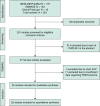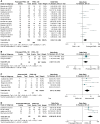P-wave duration and atrial fibrillation recurrence after catheter ablation: a systematic review and meta-analysis
- PMID: 36413611
- PMCID: PMC9935015
- DOI: 10.1093/europace/euac210
P-wave duration and atrial fibrillation recurrence after catheter ablation: a systematic review and meta-analysis
Abstract
Aims: Atrial fibrillation (AF) is a global health problem with high morbidity and mortality. Catheter ablation (CA) can reduce AF burden and symptoms, but AF recurrence (AFr) remains an issue. Simple AFr predictors like P-wave duration (PWD) could help improve AF therapy. This updated meta-analysis reviews the increasing evidence for the association of AFr with PWD and offers practical implications.
Methods and results: Publication databases were systematically searched and cohort studies reporting PWD and/or morphology at baseline and AFr after CA were included. Advanced interatrial block (aIAB) was defined as PWD ≥ 120 ms and biphasic morphology in inferior leads. Random-effects analysis was performed using the Review Manager 5.3 and R programs after study selection, quality assessment, and data extraction, to report odds ratio (OR) and confidence intervals. : Among 4175 patients in 22 studies, 1138 (27%) experienced AFr. Patients with AFr had longer PWD with a mean pooled difference of 7.8 ms (19 studies, P < 0.001). Pooled OR was 2.04 (1.16-3.58) for PWD > 120 ms (13 studies, P = 0.01), 2.42 (1.12-5.21) for PWD > 140 ms (2 studies, P = 0.02), 3.97 (1.79-8.85) for aIAB (5 studies, P < 0.001), and 10.89 (4.53-26.15) for PWD > 150 ms (4 studies, P < 0.001). There was significant heterogeneity but no publication bias detected.
Conclusion: P-wave duration is an independent predictor for AF recurrence after left atrium ablation. The AFr risk is increasing exponentially with PWD prolongation. This could facilitate risk stratification by identifying high-risk patients (aIAB, PWD > 150 ms) and adjusting follow up or interventions.
Keywords: Ablation; Atrial fibrillation; Interatrial block/conduction; P-wave; Recurrence.
© The Author(s) 2022. Published by Oxford University Press on behalf of the European Society of Cardiology.
Conflict of interest statement
Conflict of interest: None declared.
Figures





References
-
- Bayes de Luna A, Platonov P, Cosio FG, Cygankiewicz I, Pastore C, Baranowski Ret al. . Interatrial blocks. A separate entity from left atrial enlargement: a consensus report. J Electrocardiol 2012;45:445–51. - PubMed
-
- Ogawa M, Kumagai K, Vakulenko M, Yasuda T, Siegerman C, Garfinkel Aet al. . Reduction of P-wave duration and successful pulmonary vein isolation in patients with atrial fibrillation. J Cardiovasc Electrophysiol 2007;18:931–8. - PubMed
-
- Okumura Y, Watanabe I, Ohkubo K, Ashino S, Kofune M, Hashimoto Ket al. . Prediction of the efficacy of pulmonary vein isolation for the treatment of atrial fibrillation by the signal-averaged P-wave duration. Pacing Clin Electrophysiol PACE 2007;30:304–13. - PubMed
-
- Masuda M, Inoue K, Iwakura K, Okamura A, Toyoshima Y, Doi Aet al. . Impact of pulmonary vein isolation on atrial late potentials: association with the recurrence of atrial fibrillation. Europace 2013;15:501–7. - PubMed
-
- Blanche C, Tran N, Rigamonti F, Burri H, Zimmermann M. Value of P-wave signal averaging to predict atrial fibrillation recurrences after pulmonary vein isolation. Europace 2013;15:198–204. - PubMed
Publication types
MeSH terms
LinkOut - more resources
Full Text Sources
Medical

